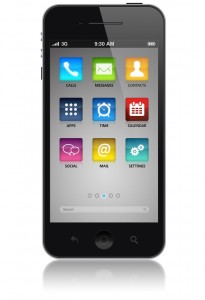A smorgasbord of leaked information and oblique evidence makes it almost certain that Apple Inc.’s (NASDAQ:AAPL) iPhone 6 will feature a 4.7 inch screen, and an additional 5.5 inch screen aimed at the phablet market is not out of the question. The leaked battery photos we reported on several days ago are interpreted by other writers as confirmation of the larger size of the next smartphone to emerge from Cupertino’s research and development department. The new battery configuration and possibly larger size indicate the iPhone 6 is bigger, too.
This circumstance prompts the question – what is the future of apps on the new, larger screen, with its increased resolution? The iPhone 6’s screen is rumored to have a resolution of 326 pixels per inch, giving it overall dimensions of 1,334 by 750 pixels. This contrasts with the iPhone 5’s 1,136 by 640 pixel resolution. Obviously, something will need to be done to accommodate existing apps, which are designed for the smaller screen. As some analysts note, the new resolution does not permit apps to be scaled up cleanly to the new size from the old.
 One possible solution, which seems quite plausible, is that older apps will simply be letterboxed, creating a black border that takes up the space between the old screen size and the new. New apps, and updated older apps, would eliminate the letterbox and allow the app graphic to flow all the way to the edges of the display. This would serve the double purpose of functionality and of maintaining good relations with existing app developers, who are a crucial revenue stream for Apple (AAPL).
One possible solution, which seems quite plausible, is that older apps will simply be letterboxed, creating a black border that takes up the space between the old screen size and the new. New apps, and updated older apps, would eliminate the letterbox and allow the app graphic to flow all the way to the edges of the display. This would serve the double purpose of functionality and of maintaining good relations with existing app developers, who are a crucial revenue stream for Apple (AAPL).
There is some precedent for the letterbox solution, in that a similar method was used in 2010 for iPhone apps running on the iPad. Alternatively, Apple (AAPL) might simply scale existing apps up, even if that caused some problems with their graphics. This would produce rather hideous results in some cases, but would solve the problem directly and quickly.
The whole matter underlines that app designers will soon be confronted with new challenges, however. If the Cupertino electronics giant is indeed planning to produce a larger iPhone and a phablet-sized phone in the near future, then apps will need to function on three different screen resolutions with radically different memory demands and rendering characteristics. Apps could conceivably be written for legacy iPhones (current models), 4.7 inch iPhones, and 6 inch iPhones in the near future.
The decision will have to be made on which resolution to support – whether development resources are sufficient to create an app that will run on all three, or if one should be supported, making design easier but limiting the number of adopters. Apple Inc.’s (AAPL) large screen decision is likely to have repercussions beyond the immediate “wow factor” of a bigger, crisper, faster iPhone display.



